Bear with me: I’m starting with a tangent even more off-track than usual. Also, this post will make no sense unless you’ve read my previous ones on Mad Venture.
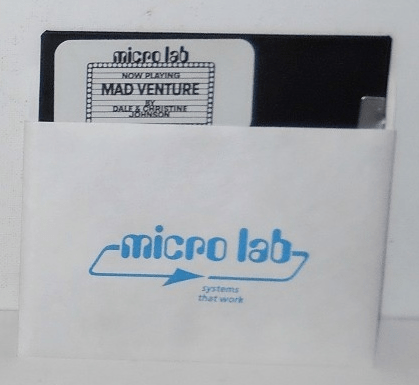
We’ll get back to this shortly, I promise.
Underneath almost any game is a second game, one that perhaps only bears partial resemblance to the original. To illustrate my point, consider Elmo’s ABCs (1998) for the Game Boy Color.
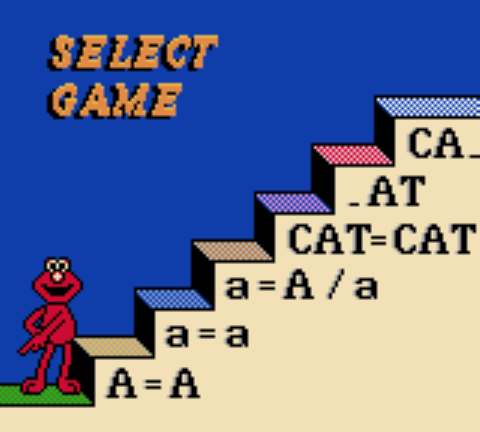
The game involves six learning activities, all requiring the player to pick the right letter from some balls that Elmo is juggling:
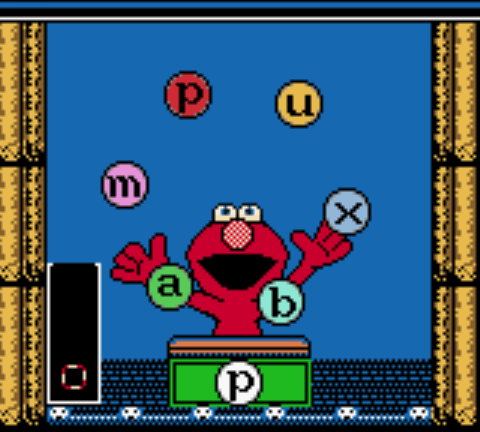
The letters rotate slowly. In the example above, when the “p” is in front of Elmo, the player must push a button to deposit the “p” in the box to the lower-left.
By all surface measures, this is simply testing the letter-recognition ability of small children, and the animation is simply a mechanic to make the game slightly less mundane as a trivia quiz. But for those who follow speedruns, it may not be a surprise that, yes, people speedrun Elmo’s ABCs. The Any% category has 9 scores on the leaderboard, with the world record at 2 minutes and 32 seconds.
This is not a joke: people have put serious work into optimizing the game, including manipulating the random number generation in order to get favorable ball placement (so you don’t have to wait so long for them to go slowly around the circle).
Exhibit A:
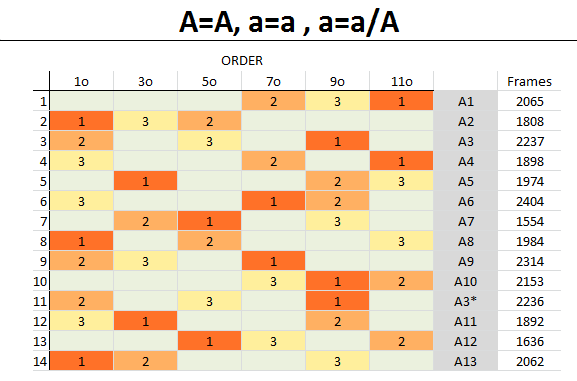
Exhibit B:

This is glorious. I may have done some nerdy things in gaming, but I can’t say I’ve made a spreadsheet analyzing the frames in a children’s game from the 1990s.
By diving into the number-of-frames level, speedrunners of Elmo’s ABCs essentially discovered a new game hidden within the game, one generated essentially by accident via the system of random number generation used by the programmers. There’s a 15 minute Youtube documentary with exhaustive detail.
In the text adventure universe, while Zork I does has a time-based leaderboard (world record 3 minutes 25 seconds), the “optimization game” under the main game is normally about raw number of turns. This has been implicit from the very begining, with Adventure having a lamp with limited turns and many games following. Adventure 430 (Woods’s own extension of Adventure 350) had point bonuses for finishing under particular move counts (including one bonus I am unsure if it is even possible to get).
The box art for Mad Venture mentions “185 moves, 400 points” explicitly. It is possible to get 400 points without beating the turn limit; the optimizing for a “best ending” only needs to come later. Even more explicitly than any text adventure that came before, optimizing feels like an entire hidden “second game” with different conditions than the main game.
400 out of 400
Before even thinking of optimizing, I needed to get all the points and treasures first. Unfortunately, the puzzles that remained from last time were mostly disappointing.
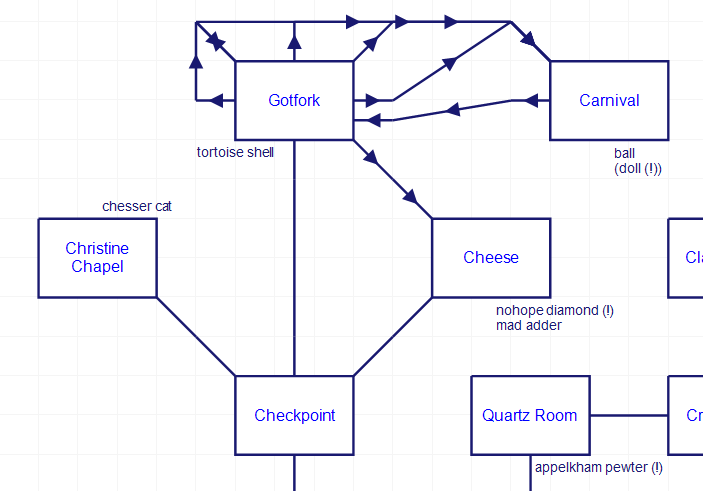
In the GET FORK area, I had missed an room; in the room Gotfork most of the exits go in a loop back to the same room (“YOU HAVE CRAWLED AROUND IN CIRCLES AND WOUND UP BACK WHERE YOU STARTED.”), except sometimes, entirely at random, you’ll land in a carnival. (The “entirely random” part will become important when I reach the “185 moves” part of the game.)

This puzzle is sort of fair. I didn’t quite have the thinking of the authors (Dale and Christine Johnson) down. Rather than presenting an obstacle to overcome, this room was inviting the creation of a set-piece to match the room description.
>DROP BOTTLE
OK.
>GET BALL
OK.
>THROW BALL
A STRIKE! YOU TOPPLED THE MILK BOTTLE WITH THAT THROW! A ROCK SLIDES OPEN AND A RARE PORCELAIN KEWPIE DOLL FALLS OUT! THE ROCK QUICKLY SNAPS SHUT.
The doll is doubly useful, because if you lose the doll, you can get another one. If you remember the beggar from last time who needed a treasure: to get full points, you have to give the doll, so you can get a second doll and don’t lose any treasures in the end.
Nearby, at the room marked “Cheese” on the map, is a less-fair puzzle.
YOU ARE IN A ROOM WHOSE WALLS RESEMBLE LIMBURGER CHEESE.
THE ONLY EXIT IS THE WAY YOU CAME IN.EXITS: YOU FIGURE IT OUT!
OBJECTS: NOHOPE DIAMOND! MAD ADDER AROUND IT!
The giant snake can be fended off via fork.
>THROW FORK
NICE SHOT! WITH YOUR FORK IN HIS SIDE, THE WOUNDED ADDER CRAWLS AWAY.
Note there’s a turtle shell in the adjacent room; if you leave it be before forking the snake, the snake will curl up in the shell and die, leaving the fork. If you’ve taken or moved the shell, the snake just disappears. The only reason to suspect there might be something wrong with the snake disappearing is that the fork counts as a treasure. I suspect most people who solved it “legit” (I looked it up) did so by accident rather than by thinking about it, even though “finding an enclosed place to curl up in” is reasonable for snakes.
The “you figure it out” part mentioned in EXITS was also a hassle. The right way to escape is:
>BACK
The text says THE ONLY EXIT IS THE WAY YOU CAME IN, which has to be interpreted as the verb BACK. This sort of follows the same pattern as the ON and OFF puzzle, but at least that one technically made sense in “the real world”; typing BACK is purely a parser-based solution and there’s no clear action attached. (That is, why does BACK differ from just going in a particular direction?)
I had noticed at the odd “L I B R A R Y” room that I could read the book for a new message…

…but I was stumped from there. If you go down (to a room that’s dark, because the lamp can’t fit inside) and type PLUMM it teleports you to the movie lobby (where the treasures go) and back. This teleportation allows you to bring in the lamp after all and find a revolver which counts as a treasure.
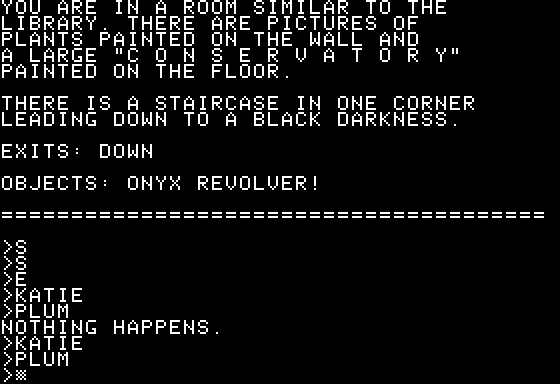
Or you can type just PLUM since the game only recognizes the first four letters of each word.
The CHESSER CAT I mentioned being stumped by was resolved by simply typing PET CAT, which led me to a maze

This was an absolute pain in the neck and I gave up mapping and deferred to the expertise of Kim Schuette.

One final obstacle involved a TUESDAY RUBY. If you try to teleport with it the normal way (KATIE) you get sent back to the room it started in. In the maze above, there’s an exit that drops you back in the DEPOSIT CHUTE room so you can hike back to the movie lobby and drop off the ruby sans teleportation.
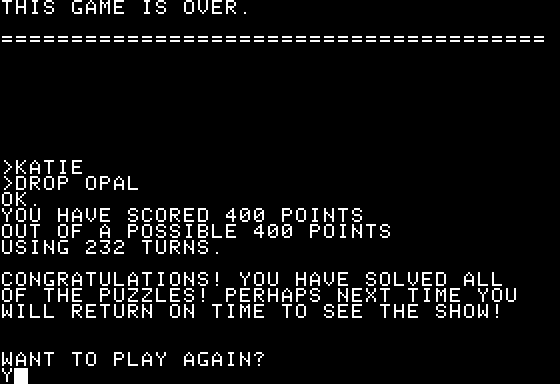
That was pretty much it — I did say the remaining puzzles were disappointing. I guess BACK counted as a sort of wordplay puzzle but all the ideas were used only once so no sort of system was built up (as would later happen in Nord and Bert, Ad Verbum, Counterfeit Monkey, and other games).
Where things really started to go off-kilter is when I went for 185 out of 185. Just to be clear, the guide I was using does not help with the optimization part, and I did need to write my own walkthrough.
185 out of 185
The first part of my journey in trying to get Mad Venture’s best ending was traditional: thinking about what actions needed to come before others, and clumping runs where I picked up treasures into groups. The inventory limit is technically 6, but the lamp must be carried essentially at all times, so some juggling happened with the five remaining slots.

For example, the doll at “1” needs to be obtained before reaching the beggar at “2”. That means any route will necessarily pass by the adder-with-diamond (at “a”) so I grabbed the diamond as one of my five slots. The doll went to the beggar (so didn’t take up one slot) and I was able to fit the treasures at “b”, “c”, “d”, and “e” in my inventory before making a trip back to the lobby to drop the treasures off.
After some rearranging and squeezing what I assumed was every possible step possible, I still didn’t quite the list down to 185 moves; I was at 195, 10 too many.
I struggled for a while figuring out where to find them, until I reconsidered my opening. Here were the starting steps of my original walkthrough:
GET KEY. N. GET LAMP. GET CROWBAR. N. GET BOTTLE. GET SANDWICH
N. N. UNLOCK DOOR. GO DOOR. GET BOOK. W. LIGHT LAMP
DEPOSIT KEY. DEPOSIT CROWBAR. DEPOSIT BOTTLE. DEPOSIT BOOK. DEPOSIT LAMP. E. S. S. EAT SANDWICH. GO HOLE. EAT KEY.
This solves the opening puzzle with the sandwich and the edible key the “normal” way. However, I realized that solving the sandwich puzzle does not actually give any points. Of equal importance: the word KATIE works without solving any puzzles! In many games, there would be some prohibition to make sure the puzzle was solved the “right” way so you’d have to go through the shrink-and-eat-key-to-get-big process (even potentially randomizing the magic word needed, like Adventure 430 does) but it appears not only does the game let you sidestep solving the puzzle, it requires sidestepping the puzzle in order to get a best ending!
GET KEY. N. GET LAMP. GET CROWBAR. N. GET BOTTLE. N. N. UNLOCK DOOR
GO DOOR. GET BOOK. S. S. S. S. S. E. PLUM.
LIGHT LAMP. D. DROP BOOK. D. GET REVOLVER. PLUM. DROP REVOLVER. KATIE.
This felt like I was breaking into a second game with a different structure: now the sandwich was no longer the essential item for solving the first puzzle, but a red herring.
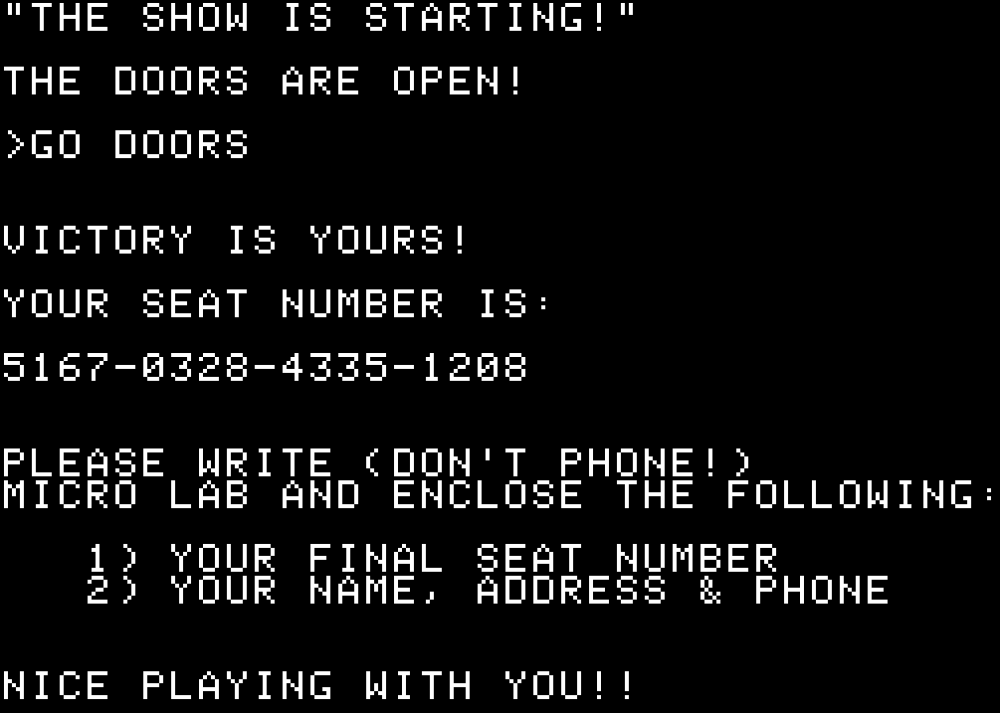
I’m not sure what the seat number code is about.
One last piece of evil: I did say the entrance to the carnival is randomized, and you need to enter it twice. I’m not certain as to the chance of success but I believe it’s somewhere around 20%. So to get through without saving requires getting a 20% luck chance, twice.
My walkthrough has 183 moves; 185 are allowed. The extra two moves can be used to save a game! So the game intends for you to save and reload until you get the right random chance at those positions. I found this utterly, profoundly off-kilter to my views of how games are supposed to work. This sort of thing happens in speedruns, or “cheating” at adventures, but in optimizing Mad Venture, the hidden game became the primary one.
I gave Mad Venture a shot back in the day. I never solved it. I got as far as the FORK (which I thought was genius!) The Limburger room (Adventure joke) and the mirror maze also stir memories.
So maybe I saw most of the map? Of course, since I was stuck, I had the impression of a vast, Zork-sized game of which I had just barely scratched the surface! Thus does nostalgia make fools of us all — I remember Mad Venture as being much better than it actually was.
(At one point I even tried disassembling the disk data, trying to get clues that way. I didn’t get very far there either.)
Anyway, I still admire the anything-goes spirit of the puzzles. Yes, it sometimes makes no sense as a world model, but you can tell (as with the FORK) that this was at least somewhat on purpose. The idea that skipping puzzles and using SAVE are part of the optimal solution feels right in line with that.
Do you remember your thought process in solving for the fork?
I didn’t solve the fork *puzzle*; I did TAKE FORK and then realized that the “fork in the road” had disappeared.
I’m a little impressed that that really short Zork run appears to be just a fast typist with good luck against the RNG.
typing BACK is purely a parser-based solution and there’s no clear action attached. (That is, why does BACK differ from just going in a particular direction?)
Perhaps you are literally backing up? That is, walking into the room, stopping, and immediately backing out again, rather than turning around.
Err, the end of the thought about Zork was “and not some sort of cheat/tool-assist”.
Tool-assisted speedruns are a thing, but that’s a different leaderboard. The only turn-based text-ish one I know of that’s interesting is Nethack’s.
http://tasvideos.org/5085S.html
I am VERY disappointed in myself that I did not solve the cat puzzle. I would always do that in a modern game! I’m also disappointed in the game that the misspelling of “Cheshire” doesn’t seem to have been on purpose or had any significance.
On the one hand I can kind of understand the Limburger puzzle, because there are lots of holes in the wall and just going NW (or whatever direction) might be taken to go into a random one of those holes, whereas BACK means right back through the hole you came through. On the other hand, Limburger doesn’t seem to have that many holes.
I was going to say something about needing to discover the magic words in one run and then ignore the means of discovering them in the speedrun being like any game with a maze and a time limit, where you need to map the maze in one run and then use the ideal route in the speedrun. But I guess you don’t need a maze for that, since you will have to figure out the puzzles and their dependencies in one run and then do them in the correct order in a speedrun. I guess maybe the difference is that when you solve puzzles in a specific order, you’re still solving all the individual puzzles, but with mazes and magic words you’re short-circuiting the puzzle and just applying the solution?
Speaking of which, do you need the book for the speedrun? I tried GET KEY. N. GET LAMP. GET CROWBAR. N GET BOTTLE. N. N. UNLOCK DOOR (seems necessary for getting back from the deposit chute with the ruby). S.S.S.S.E.PLUM.LIGHT LAMP. GET REVOLVER.PLUM.DROP REVOLVER.KATIE and it seems to work.
Usually (i.e. optimizing Adventure) there’s at least some possibility of verisimilitude (a hero that just happens to know their way through the maze); with this game the initial route has to bypass the main game in an almost nonsensical, self-aware way.
You need the book. You get 15 points for dropping it in the library. (You get the message “THIS BOOK IS OVERDUE!” after you return it.)
I guess I always dumped the book before getting to the library, though it makes sense that you need to bring it there.
Is the hero happening to know their way through maze any different from the hero happening to know the magic words that let them avoid using the sandwich to shrink themselves down the rabbit hole? It lets you skip lots of puzzles but so does mapping the maze in a previous runthrough.
It’s nice that you can get all the points without beating the timer, and that you get a “Congratulations!” message instead of “The Wizard Astrix tells you what a slowpoke you are and commits suicide.”
I mean, in a sense, the entire map in any of these games is a “maze”, so it’s a little different, yeah.
I guess one comparison would be to cinema and television. If someone was wandering a map just finding the layout you’d cut a lot of the “returning” parts but still be able to convey a whole narrative without it seeming like anything was too amiss.
But skipping a puzzle entirely which is central to the plot is like having part of the film cut out.
I had this game back in the day at a very young age; my dad had purchased an Apple computer with a large inheritance from my grandfather. The box looked very different from the one shown, with splashy, colorful graphics. The game was presented as a contest; solving it could win you an actual cash prize. This would explain why it is so difficult, and why getting back to the theater on time earned you a unique code to send to the developers.
I ran across your blog during a search for this game, only remembering the “Tuesday Ruby” and “Bailey Pearl” elements of the game. I never did solve it and often wondered if someone ever claimed the prize.
Do you remember how much the cash prize was?
I suppose the current Internet versions were a later release after the contest was over.
You might like trying Palace in Thunderland! It’s got a Mad Venture flavor and is still pretty hard but it is still much more “solvable” and also doesn’t have a nasty maze. You can play Palace online here (you need to press “R” for Run, and then pick “A” which is Thunderland on the menu).
The prize wasn’t cash, but a single copy of any program that Micro Lab published at the time, offered to the first person who was able to send in the code from the best ending. This was mentioned in the first ads for the game circa spring ’81, but had disappeared by the time they were advertising it together with Palace in Thunderland by that autumn. I’m not currently aware of any announcement of a winner. They also offered a prize (a plaque), for the first 10 players to send in a similar in-game code as proof of scoring over 10000 points in ads for their first game, the relatively more popular Dogfight. Interestingly, they did indeed release a revised and improved version of Dogfight later on, which may or may not have removed the contest code, but I’ve not been able to find any evidence that they did the same for Mad Venture. As for the packaging, it seems to be very rare now, and the only image I can find online is the one you used (presumably from MOCAGH), of the era-standard monochrome (with some red) baggy and card. Micro Lab did keep advertising it (in a low-key way) in their largely non-game software focused ads through at least late ’82, so the comment above raises an intriguing question about whether they may have switched over to a more elaborate boxed packaging at some point. I’d love to see an example, if any exist.
I do remember the prize being cash and it being a number like $1,000 or $5,000. Games were hella expensive back then (most being the equivalent of $150 each today), and our motivation for purchasing this particular game was a chance to win the prize. The packaging pictured here is not at all familiar.
I still have several Infocom games packed away in storage; I will dig through those boxes and see if, by some chance, I also kept the Mad Venture game. I really appreciate all the info provided here; I had only the vaguest memories of this game and now so much of it is coming back to me.